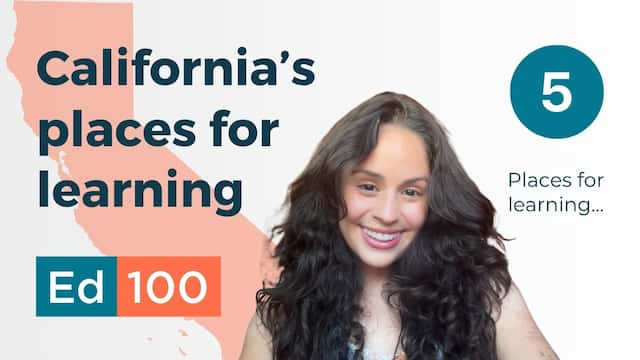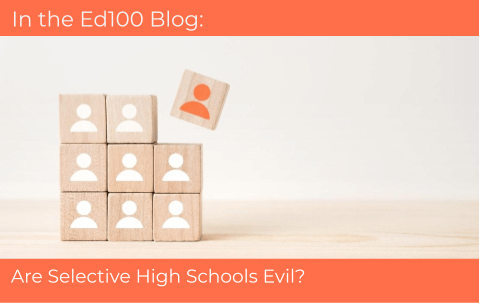
Overall, California's student body is incredibly diverse. On closer inspection, it is well sorted.
In This Lesson

What is differentiated instruction?
What is tracking?
Does tracking work?
Is tracking of students fair?
How do programs for gifted students work?
Should you send your child to a single-sex school?
Pros and cons of single-sex education
Are single-sex schools better?
▶ Watch the video summary
★ Discussion Guide
Throughout childhood, students get used to being sorted: they are sorted by age, by gender, by height, by neighborhood. They are sorted by interest, or readiness, or preference, or luck. Not so long ago, students were explicitly sorted by race. As discussed in Lesson 5.1, today sorting persists by zip code or community, often with similar effect.
This lesson focuses on sorting that schools and educators do intentionally, as part of their educational strategy, as well as sorting that just happens.
Academic sorting
Schools routinely sort students academically. Classes are organized into grade levels and then further into learning groups. In lower grades, students are often sorted into math groups and reading groups. In higher grades they are separated into courses and classes. In many high schools, Advanced Placement (AP) courses are the academic equivalent of varsity: not all students make the team. Some schools allow students to enroll in these challenging courses based on their interest. But allowing isn't the same as encouraging or requiring. Many colleges and some high schools are selective; students must demonstrate their ability and commitment to gain admission.
What is tracking?
The practice of grouping students according to readiness or ability is known as tracking, particularly where groupings persist from one course to the next. Tracking often begins in elementary and middle grades in the form of reading groups or math levels. In middle and high school grade levels, tracking is particularly common for math classes because more advanced concepts build from less advanced ones. It's difficult and risky to skip steps.
Education equity advocates tend to dislike tracking, especially in mathematics. The main alternative is called differentiated instruction, an approach that requires teachers to serve multiple learning levels in the same class. Not all educators agree that this improves results for students, especially those who are relatively advanced. Arguments in favor of tracking can be found in this article from Education Next and this one from the Atlantic.
Selective policies tend to benefit those who ask
Grouping by interest
Some schools work to attract similar birds of a feather as part of an educational strategy. For example, some schools promote their emphasis on the arts. Others promise an enhanced focus on technology. Schools that emphasize Gifted And Talented programs (GATE) attempt to identify students with exceptional academic promise and provide extra learning opportunities appropriate for their needs.
Sort if you like, but don't expect extra money
In the past, both the federal budget and the state budget included funds to support programs for gifted students. As we discuss in length in the Ed100 blog, little remains of that support. Some gifted programs remain here and there, but they are sufficiently rare that the National Association for Gifted Children has difficulty even collecting useful information for an annual report.
California school districts may offer programs for gifted students (it's allowed) but they don't have to. It is entirely a matter of local control.
Co-ed schools, or keep 'em separated?
Single-sex schools were somewhat common in America prior to the civil rights era, when co-education became the expectation in public education. In 1996, the US Supreme Court ruled in United States v. Virginia that under some circumstances gender-separated public schools can be separate but equal. The number of gender-separate schools remains quite small, though the number has risen slightly in recent years according to 2023 reporting from GreatSchools. The most important relevant research and reporting about the effects of gender separation in education is from Ireland, where it remains a common practice in a minority of schools.
The minimal available research, mostly from Catholic schools, suggests that all other things being equal, academic achievement is generally higher in single-sex school classrooms than in co-ed ones, but the research finding is not straightforward. Like most social science, the data are messy and the validity of this conclusion can be disputed.
California’s first new single-sex public school in twenty years opened in Los Angeles in 2016. It’s an all-girls school. California law prohibits sex-segregated schools, but federal law permits them. LAUSD obtained a California waiver from the State Board of Education to open the school. Very few public gender-specific schools have been opened since then.
Selective public schools exist, but are rare
It is common for private schools to be selective, but selective public schools are rare. In California there are very few of them, including Lowell High School in San Francisco. In 2022, the school briefly converted to a lottery-based admission system. The move was deeply unpopular, and it contributed to the recall of several members of the school district board. Read more about it in the Ed100 blog.
Want to be selected? Stand up for yourself!
At the risk of stating the obvious, selective policies tend to benefit those who ask to be selected. Selecting anything (or being selected for something) usually requires action, even a small one like raising a hand, filling out a form, or talking to a teacher. These small barriers requiring student self-advocacy or parent advocacy tend to reinforce patterns of selection, even unintentionally.
Each school, intentionally or unintentionally, develops its own reputation for the ways in which it is selective and the ways in which it is diverse. In cases where parents have a choice about where their children attend school, they respond to these signals. Parents can influence the balance their local schools strike between these two competing values.
The next lesson will examine the role of special schools for children at risk.
This lesson was updated March 2024.
CHAPTER 5:
Places For Learning
-
Places For Learning
Overview of Chapter 5 -
Where Are the Good Schools?
Zip Codes and School Quality -
School Choice
Policies for Placing Students -
Selective School Programs
How Schools Sort Students -
Continuation Schools
When Regular School Doesn't Cut It -
Charter Schools
Public Schools, Different Rules -
Private Schools
Tuition, Vouchers, and Religion -
Community Schools
Services Beyond Classwork -
Principals and Superintendents
The Pivotal Role of an Educational Leader -
School Facilities
What Should a School Look Like? -
School Climate
What Makes a School Good? -
Small Schools
Are They Better? -
Home Schools
How Do They Work? -
School Discipline and Safety
Suspensions and Other Options
Related
- There are no related lessons.
Sharing is caring!
Password Reset
Search all lesson and blog content here.
Login with Email
We will send your Login Link to your email
address. Click on the link and you will be
logged into Ed100. No more passwords to
remember!
















Questions & Comments
To comment or reply, please sign in .
Carol Kocivar June 13, 2022 at 8:56 pm
Our blog “Are selective schools evil?” explains the issues.
https://ed100.org/blog/selective-high-schools
https://ed100.org/blog/selective-high-schools
Carol Kocivar June 5, 2022 at 6:14 pm
"In recent years, some school systems have detracked math programs, in particular, to address achievement gaps, and California is considering doing so statewide through 10th grade.
Math is the most-tracked subject, and proponents of detracking – including the National Council of Supervisors of Mathematics – argue that eliminating tracking creates more equal opportunities for all students.
But California’s proposals have fueled heated debate, with opponents arguing that detracking is unfair to students who are more advanced learners."
https://www.usnews.com/education/k12/articles/detracking-in-k-12-classrooms?utm_source=usn_tw&utm_campaign=tw_edu
Caroline February 18, 2020 at 1:13 pm
Pamela Wright April 16, 2018 at 3:48 am
Jeff Camp - Founder April 17, 2018 at 12:37 pm
francisco molina February 23, 2019 at 10:55 am
francisco molina February 23, 2019 at 11:01 am
jen_bullock December 5, 2017 at 7:43 pm
[Ed100 Editor note: messages like this one from Jennifer are VITALLY helpful. We couldn't keep Ed100 up to date without tips from our readers.]
Jeff Camp - Founder July 28, 2016 at 3:11 pm
_Bruce Ross August 26, 2015 at 8:31 am
Obvious, but until you see it play out, it is not obvious how strong the effect is.
I live in a county that effectively has open enrollment and free transfers wherever there is room. (The County Board set the policy years back, and since they will grant any transfer that a district denies, there's no point in denying them.) It's not really an ethnic/racial thing, but it broadens the divide between the aspirational middle class and everyone else. Our kids attend and I love our neighborhood school, but it is striking -- and sad -- how many of my peers literally would not think of sending a child there.
Jeff Camp - Founder September 24, 2014 at 3:03 pm
The short version: the research found evidence that gifted programs may work best for motivated students that are NOT classically "gifted" with a high IQ. The EdExcellence take: "So why would a program impact high scorers and not those with high IQ? Perhaps high test scores demonstrate non-cognitive traits, like longer attention spans and willingness to meet social expectations, which are important in gifted classrooms. In any event, the findings suggest that creating separate classrooms in every school for top-performing students is a cost-effective way to significantly boost performance, even in the poorest neighborhoods."
The full report sells for $5 at http://www.nber.org/papers/w20453
Brenda Etterbeek June 15, 2019 at 2:09 pm
Caprice Young April 23, 2011 at 10:54 pm
Grouping students with like interests and learning needs can be a great way to deliver high quality education in a more individualized way. As long as the placements are made thoughtfully and at the choice of the students' guardians, more specialized educational environments can really work well.
I participated in the bussing folly of LAUSD 30 years ago (yeah, I'm ancient). Merely bussing kids across town did nothing to integrate the classrooms or lunch areas. However, in Magnet schools, which select students in a lottery basis in order to group students by interest or learning style, we actually shared classrooms, libraries, lunch pavilions and friends. It took away that awkwardnes and let us get to know eachother as people with similar interests-- which is how friendships more naturally form.
David B. Cohen April 20, 2011 at 10:43 am